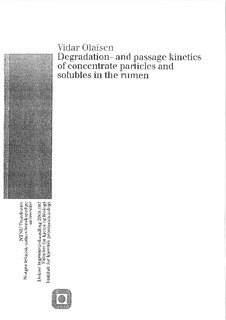| dc.contributor.author | Olaisen, Vidar | nb_NO |
| dc.date.accessioned | 2014-12-19T13:10:55Z | |
| dc.date.available | 2014-12-19T13:10:55Z | |
| dc.date.created | 2006-05-09 | nb_NO |
| dc.date.issued | 2001 | nb_NO |
| dc.identifier | 125945 | nb_NO |
| dc.identifier.isbn | 82-471-5377-7 | nb_NO |
| dc.identifier.uri | http://hdl.handle.net/11250/244520 | |
| dc.description.abstract | This thesis deals with three actual issues of ruminant degradation and escape of dietary components:
One of the main emphasis has been on how particle size distribution of concentrated feed affects the degradation and ruminal escape. Feed manufacturers producing compound feeds for ruminants want to increase the fraction of undergraded starch and protein feed passing out of the rumen, and the particle size distribution of the feed may be used to increase this fraction. The residence time distribution of concentrate particle was not much affected by the particle size in the range from 0.1 to 2.8 mm, but the degradation kinetics of barley and maize was substantially depressed by increased particle size. For maize the ruminal degradability was strongly dependent of the particle size, but for barely this effect was much weaker because the degradation kinetics was much faster than the passage kinetics. However, expander treatment of barely to reduce protein degradability would probably increase the effects of particle size on degradability since this treatment decrease the degradation rates.
The second part of this thesis deals with the possibilities to simplify the laborious in situ technique used for ruminal degradation measurements in Norway. This study showed that the number of incubation times could be reduced to two or three without sacrificing much accuracy. The amount of human work and the total incubation time could therefore be reduced by this method.
In the last part of this thesis we study the degradation of soluble nitrogen fractions of fresh grass and grass silage, which are the main forages in Norway. Half or more of the total N in grass silage is in the form of soluble non-protein nitrogen – mainly small peptides and free amino acids. Therefore, it is important to know how much of the soluble peptides and free amino acids that escaped the rumen to improve the accuracy of determination of the protein value of grass and grass silage. The results obtained showed that approximately 10% of the soluble dietary nitrogen escaped the rumen, and the data also indicated that the synthesis of microbial protein from fresh grass was more efficient than silage, caused by a better access to energy for this synthesis. | nb_NO |
| dc.language | eng | nb_NO |
| dc.publisher | Fakultet for naturvitenskap og teknologi | nb_NO |
| dc.relation.ispartofseries | Dr.ingeniøravhandling, 0809-103X; 2001:107 | nb_NO |
| dc.relation.haspart | Olaisen, V; Nesse, N; Volden, H. Technical note: use of laser diffraction for particle size distribution measurements in duodenal digesta. J. Anim. Sci. 78: 761-756, 2001. | nb_NO |
| dc.relation.haspart | Olaisen, V; Volden, H; Nesse, N. The effect of particle size and sedimentation velocity on the flow resistance out of rumen. . | nb_NO |
| dc.relation.haspart | Olaisen, V; Volden, H; Mejdell, T; Nesse, N. The effect of consentrate particle size on degrafation and passage rate in the rumen. . | nb_NO |
| dc.relation.haspart | Olaisen, V. Modelling the barley and maize effective degradability of starch and protein as a function of particle size. . | nb_NO |
| dc.relation.haspart | Olaisen, V; Mejdell, T; Volden, H; Nesse, N. Simplified in situ method for estimating ruminal dry matter and protein degradability of concentrates. J. Anim. Sci.. 81: 520-528, 2003. | nb_NO |
| dc.subject | TECHNOLOGY: Chemical engineering | en_GB |
| dc.title | Degradation- and Passage Kinetics of Concentrate Particles and Solubles in the Rumen | nb_NO |
| dc.type | Doctoral thesis | nb_NO |
| dc.contributor.department | Norges teknisk-naturvitenskapelige universitet, Fakultet for naturvitenskap og teknologi | nb_NO |
| dc.description.degree | dr.ing. | nb_NO |
| dc.description.degree | dr.ing. | en_GB |
